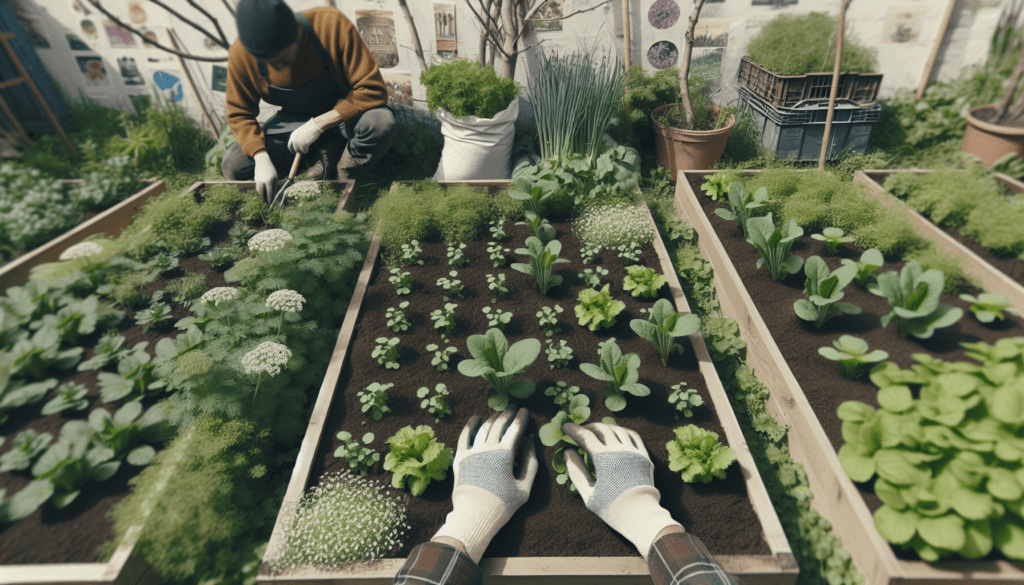Are weeds taking over your small urban garden? Don’t worry, there are simple and effective ways to regain control. In this article, you will discover the best ways to combat those pesky weeds and maintain a thriving garden in the midst of the urban jungle. From utilizing mulch and organic weed killers to implementing smart planting techniques, you’ll soon be enjoying a weed-free haven right in your own backyard. So, let’s get started and reclaim your garden from those unwanted intruders.
1. Mulching
Mulching is one of the most effective and popular methods for controlling weeds in small urban gardens. By covering the soil around your plants with a layer of mulch, you can inhibit the growth of weeds and create a healthy environment for your plants to thrive. There are several types of mulch that you can choose from, including organic mulch and inorganic mulch.
1.1 Types of Mulch
Organic Mulch: This type of mulch is made from natural materials such as straw, wood chips, grass clippings, or shredded leaves. Organic mulch not only helps to control weeds but also adds nutrients to the soil as it breaks down. It also improves soil moisture retention and prevents erosion.
Inorganic Mulch: Inorganic mulch includes materials like rocks, gravel, or plastic. While they do not provide any nutrients to the soil, inorganic mulches are excellent at suppressing weed growth. They are also more long-lasting and require less maintenance compared to organic mulches.
1.2 How to Apply Mulch
To apply mulch effectively, start by clearing the area of any existing weeds or plants. Then, lay down a layer of mulch around your desirable plants, ensuring that the mulch is at least 2 to 3 inches thick. Be careful not to bury the stems or trunks of your plants, as this can lead to rotting. Leave a small gap around the base of the plants to allow for air circulation.
1.3 Benefits of Mulching
Mulching comes with numerous benefits apart from weed control. It helps to regulate soil temperature, keeping it cooler in the summer and warmer in the winter. Mulch also retains water, reducing the need for frequent irrigation and preventing soil erosion. Additionally, it improves the aesthetics of your garden by providing a neat and tidy appearance.
2. Hand Pulling
Hand pulling is another effective method for controlling weeds in small urban gardens, especially for those hard-to-reach areas or when dealing with specific types of weeds. This manual technique involves physically removing the weeds from the soil by hand.
2.1 Tools for Hand Pulling
To make hand pulling more efficient, you can use a few simple tools such as a hand trowel, weeding fork, or a specialized weeding tool. A hand trowel is useful for loosening the soil around the weed, making it easier to pull out the entire root system. A weeding fork can help you lift out deep-rooted weeds, while a specialized weeding tool can provide better leverage and grip for stubborn weeds.
2.2 Tips for Effective Hand Pulling
When hand pulling weeds, it’s important to ensure that you remove the entire plant, including its roots. Pull the weed gently but firmly, making sure to get as much of the root system as possible. If the weed is particularly challenging, you can wet the soil beforehand to make it easier to pull. Remember to dispose of the pulled weeds properly to prevent reinfestation.

3. Regular Maintenance
Regular maintenance is key to preventing weed growth and maintaining a healthy garden. By adhering to a consistent maintenance routine, you can stay on top of weed growth and minimize the effort required to control them in the long run.
3.1 Importance of Regular Maintenance
Regular maintenance helps to prevent weeds from establishing a strong foothold in your garden. By regularly inspecting your garden and removing any young weeds, you can prevent them from maturing and producing seeds. Regular maintenance also allows you to spot and address any other issues, such as diseases or nutrient deficiencies, before they become major problems.
3.2 Tasks for Regular Maintenance
To maintain your garden effectively, incorporate the following tasks into your routine:
Regular weeding: Take the time to inspect your garden regularly and remove any new weed growth promptly.
Watering: Properly water your plants to ensure they are healthy and receive adequate hydration. This will help them compete with weeds more effectively.
Fertilization: Provide your plants with the necessary nutrients to promote healthy growth. Well-nourished plants are less susceptible to weed competition.
Pruning: Regularly prune your plants to remove any dead or diseased parts. This helps reduce the potential for weed infestations.
Mulch replenishment: Over time, the mulch layer may break down or get displaced. Replenish the mulch as needed to maintain an effective weed barrier.
By staying on top of these regular maintenance tasks, you can create an environment that is less conducive to weed growth and maintain a beautiful, weed-free garden.
4. Smothering
Smothering is a weed control method that involves the use of various materials to suffocate and block sunlight from reaching weed seeds or existing plants. This method is effective for suppressing weed growth in areas where you want to temporarily eliminate vegetation.
4.1 Using Landscape Fabric
Landscape fabric, also known as weed barrier fabric, is a popular smothering material used to suppress weed growth. It is a permeable fabric that allows air and water to penetrate the soil while preventing weeds from growing. To use landscape fabric, clear the area of weeds and debris, lay the fabric over the soil, and secure it in place with stakes or rocks. Cut holes in the fabric to accommodate the plants you want to grow. This method is commonly used in vegetable gardens, flower beds, or under gravel paths.
4.2 Newspapers or Cardboard as Smothering Materials
Newspapers or cardboard can also be used as inexpensive and easily accessible smothering materials. Simply lay several layers of newspapers or flattened cardboard over the area where you want to suppress weed growth. Ensure that the material is thick enough to block out sunlight. Secure the edges with rocks or mulch to prevent the wind from blowing it away. Over time, the newspapers or cardboard will break down, adding organic matter to the soil.

5. Solarization
Solarization is a natural and chemical-free method for controlling weeds and other pests using the heat generated by the sun. This technique involves covering the soil with a clear plastic sheet, which traps heat and raises the temperature of the soil to a level that kills weed seeds and seedlings.
5.1 Process of Solarization
To solarize your soil, follow these steps:
Clear the area of any existing weeds or plants.
Break up the soil with a rake or shovel to ensure it is loose and easier to heat.
Water the soil thoroughly to enhance heat penetration.
Cover the area with a clear plastic sheet, ensuring that it is tightly secured to the ground and does not allow any air to escape.
Leave the plastic in place for several weeks during the hottest months of the year, typically in summer.
After the solarization period, remove the plastic and allow the soil to cool before planting.
5.2 Ideal Conditions for Solarization
Solarization is most effective when performed during the hottest months of the year when there is ample sunlight. The process requires a minimum of 4-6 weeks of continuous sunlight for optimal results. This method works best in open, exposed areas with full sun exposure and is particularly useful for clearing heavily infested plots before planting new crops or starting a fresh garden.
6. Herbicides
Herbicides are chemical substances specifically designed to kill or inhibit the growth of unwanted plants, including weeds. They can be an effective tool for weed control in small urban gardens when used appropriately and following all safety precautions.
6.1 Selective vs. Non-Selective Herbicides
There are two main types of herbicides: selective and non-selective.
Selective herbicides target specific types of weeds, leaving desirable plants unaffected. They are useful when dealing with a particular weed species without harming your garden plants.
Non-selective herbicides, on the other hand, kill or damage all plants they come in contact with. These herbicides are best used when you need to clear an area completely before replanting, as they do not discriminate between weeds and desirable plants.
When using herbicides, it is essential to carefully follow the instructions provided by the manufacturer and take precautions to protect yourself, other plants, and the environment.
6.2 Precautions for Using Herbicides
Read and follow the instructions: Always read the label on herbicides before use and carefully follow the recommended dosage and application methods. Pay attention to any specific instructions for the type of weed you are targeting.
Wear protective clothing: Protect yourself by wearing gloves, long sleeves, long pants, and closed-toe shoes when handling and applying herbicides. Consider using a face mask or goggles to protect your eyes and respiratory system.
Avoid drift: Herbicides can drift and affect nearby plants. Apply herbicides on calm days with little to no wind to prevent accidental damage to desirable plants.
Store and dispose of herbicides properly: Keep herbicides out of reach of children and pets and store them in their original containers. Dispose of unused herbicides and empty containers following local regulations.
Remember, herbicides should be used as a last resort when other weed control methods have proven ineffective or when dealing with extensive weed infestations. Always prioritize the health and safety of your garden and the surrounding environment.

7. Companion Planting
Companion planting involves planting specific plant combinations to benefit each other in terms of growth, pest control, and weed suppression. By strategically selecting companion plants, you can reduce weed growth and create a more harmonious ecosystem within your small urban garden.
7.1 Beneficial Companion Plants for Weed Control
Ground covers: Plant low-growing ground covers like creeping thyme, chamomile, or clover between your crops or in areas prone to weed growth. These ground covers help smother weeds by blocking out sunlight and also add beauty and functionality to your garden.
Nitrogen fixers: Incorporate nitrogen-fixing plants like legumes (beans, peas, or clover) into your garden. These plants help improve soil fertility, which in turn promotes healthier and more vigorous growth of your desired plants, making them more competitive against weeds.
Allelopathic plants: Certain plants produce natural chemicals that inhibit the growth of other plants, including weeds. Examples of allelopathic plants include marigolds, sunflowers, and certain herbs like dill, fennel, or sage. Planting these companions in your garden can help suppress weed germination and growth.
Dense and fast-growing plants: Choose dense and fast-growing plants like cucumbers, squash, or melons to create a natural shade cover that shades out weeds. These vigorous plants can outcompete weeds for resources and reduce the available light for weed seed germination.
By carefully selecting and interplanting these beneficial companion plants, you can create a more weed-resistant garden that thrives in harmony.
8. Vinegar Solution
Vinegar is a highly effective and environmentally friendly weed control solution that can be easily made at home. The acetic acid in vinegar has herbicidal properties that can be utilized to kill or suppress weed growth.
8.1 Recipe for Homemade Vinegar Solution
To make a vinegar weed control solution, follow these steps:
Mix white vinegar with water: Combine equal parts of white vinegar and water in a spray bottle or a garden sprayer. For a more potent solution, you can increase the vinegar concentration.
Add dish soap: Add a few drops of liquid dish soap to the vinegar and water mixture. The soap helps the solution stick to the foliage of the weeds, enhancing its effectiveness.
Mix thoroughly: Shake the bottle or garden sprayer gently to ensure that the vinegar, water, and soap are well-mixed.
Apply to weeds: On a sunny day, spray the vinegar solution directly onto the weeds, thoroughly wetting the foliage and stems. Take care to avoid spraying desirable plants, as the vinegar can also harm them.
Repeat as needed: Vinegar is a non-selective herbicide, so it may require multiple applications to completely eradicate the weeds. Monitor the progress and reapply the solution as necessary.
It’s important to note that vinegar can also affect the soil pH, so it should be used sparingly and only in targeted areas. Avoid using vinegar as a weed control method near plants or in areas with alkaline soil.

9. Raised Beds
Raised beds offer several advantages when it comes to weed prevention and control in small urban gardens. By elevating the soil level within a confined space, raised beds create a physical barrier that limits the ability of weeds to infiltrate the garden.
9.1 Advantages of Raised Beds in Weed Prevention
Reduced weed seed bank: Raised beds typically contain fresh soil or a weed-free growing medium, minimizing the presence of weed seeds. This reduces the chances of weed germination and subsequent growth.
Clear separation from surrounding soil: The raised bed structure prevents weed seeds from neighboring areas from encroaching into your garden. This provides a level of control and containment, making weed management more manageable.
Defined planting space: With raised beds, you have clear borders and control over where you plant your desired crops or flowers. This helps prevent weeds from spreading and competing with your plants.
Improved soil structure and fertility: By focusing on a smaller area, raised beds allow for better soil management. Amending the soil with organic matter and nutrients becomes easier, promoting healthy plant growth and weed suppression.
When constructing raised beds, use materials like untreated wood, bricks, or stones to create the barriers. Ensure there is adequate drainage, and amend the soil with compost and other organic matter to promote healthy plant growth.
10. Proper Bed Preparation
Proper bed preparation is crucial for effectively controlling weeds in small urban gardens. By preparing your garden beds correctly, you can create an environment that is less conducive to weed growth and make it easier to manage any weeds that do appear.
10.1 Techniques for Effective Bed Preparation
Clear the area: Before starting a new garden bed, clear the area of any existing vegetation, including weeds. Remove the plants manually or use smothering techniques, such as smothering with cardboard or landscape fabric, to eliminate weed growth.
Loosen the soil: Using a garden fork or a tiller, loosen the soil in the bed. This makes it easier to remove any remaining weed roots and provides a better growing environment for your plants.
Amend the soil: Add compost or organic matter to the soil to improve its structure, fertility, and water-holding capacity. This will help your plants grow more robustly and better compete with any potential weeds.
Mulch the bed: After planting your desired plants, apply a layer of mulch around them. Mulch acts as a barrier, preventing weed seeds from receiving adequate light to germinate. It also helps retain soil moisture and reduces weed growth.
Monitor and maintain: Regularly inspect your garden beds for any new weed growth and address them promptly. By staying vigilant and maintaining a consistent weed control routine, you can keep your garden beds healthy and weed-free.
Proper bed preparation sets the foundation for a thriving garden and minimizes the effort required for weed control. By following these techniques, you can create an environment that promotes the growth of your desired plants while discouraging weed infestations.
In conclusion, controlling weeds in small urban gardens requires a combination of strategies tailored to your specific garden’s needs. By utilizing mulching, hand pulling, regular maintenance, smothering, solarization, herbicides (with caution), companion planting, vinegar solution, raised beds, and proper bed preparation, you can maintain a beautiful and weed-free garden. Remember to choose the methods that align with your gardening preferences, environmental concerns, and specific weed control requirements. Happy gardening!



